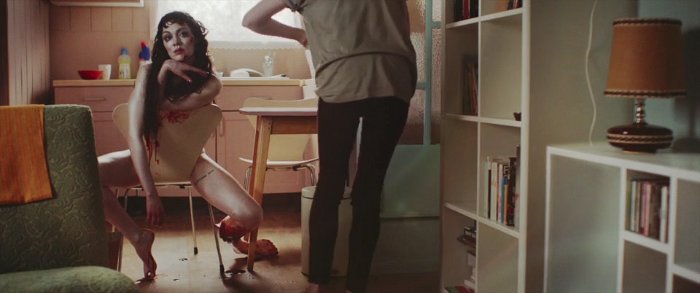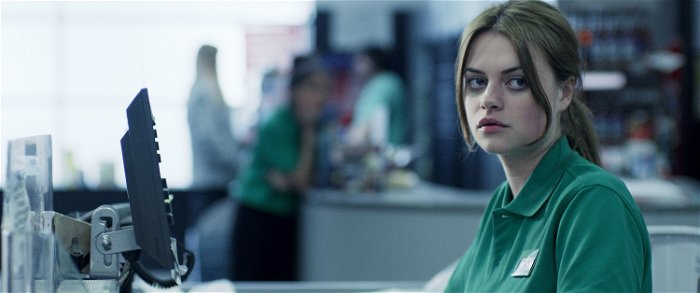It’s Valentine’s Day weekend kiddies. That means it’s time to watch a movie about love.
Not so fast though. Why waste your time in the Kate Hudson rom-com aisle when you could take a trip down a far more dark and uncomfortable path. It’s also the perfect time of year to watch a creepy and unsettling look at relationships, either as a comfort for the perpetually single or a relatable slice of realism for the unhappily coupled. This year, we’re all being treated to the release of the devilishly twisted British horror/comedy/romance/drama Nina Forever. It’s a movie that earns every single one of those genre labels thanks to the inventive imaginations of first-time filmmakers Ben and Chris Blaine.
Through a series of odd n’ entertaining short films (including Hallo Panda, the sweetest short about a professional bear masturbator you’ll ever see), the sibling filmmakers developed a unique voice that’s finally expanded into feature length with Nina Forever. It’s about a morbid young girl named Holly (Abigail Hardingham) who finds herself drawn to a suicidal co-worker named Rob (Cian Barry). Rob hasn’t gotten over the death of his ex Nina (Fiona O’Shaughnessy), but Holly persists in her pursuit anyway. Unfortunately, the long-awaited consummation of their new love is interrupted when a bloody and scared Nina rises from the dead in the middle of their bed. She continues to appear anytime Holly and Rob get intimate, which is obviously a bit awkward. The weird part is, Holly might like it.

So yeah, it’s not exactly your average, everyday love story. Dripping with blood and swimming in difficult emotions, Nina Forever is a tricky film to classify. It’s certainly disturbing enough to be horror and funny enough to be comedy, yet the film is also a rather thoughtful meditation on loss, grief, and the challenge of moving on. Nina Forever is a delightfully twisted debut well worth seeking out for genre lovers looking for something with a little meat on its rattling bones.
The film is also an impressive debut for a pair of fresh filmmakers well worth following. To celebrate the long-awaited Canadian release of their delightful debut, Comics Gaming Magazine got a chance to chat with Nina Forever co-writers/directors Ben and Chris Blaine. We picked their brains about everything from the personal origins of the project to their genre bending ways, the importance of mixing K-Y Jelly with fake blood, and the 2.5-hour Biblical epic that they made in high school.
You know, all of the important subjects.
Comics & Gaming Magazine: All right, boring question first: where did the idea for Nina Forever spring from? Did one of you guys go through a rough relationship?
Ben Blaine: A few! It’s a documentary.
Chris Blaine: It’s something that took a long time to develop into what it is. It’s an idea we’ve been working on for something like ten years, I think. But actually writing it came out really quickly. We’d been going through losing people together quite a lot. So we were in a specific place while writing it, talking about all that turmoil stuff that’s going on in your head. It felt very natural to be writing it at that point, so the first draft came out in I think…three weeks?
BB: Yeah, three or four weeks.
CB: It was really quick and it felt right straight away. So it’s definitely got a lot to do with grief; seeing people go through it and experiencing it ourselves. It’s very much trying to explain visually and metaphorically all of the things that you go through when you lose someone, whether that’s losing them through death or breaking up with them.

CGM: From the short films I found online, it didn’t seem like you guys had made anything in the horror genre before. Was that something you always wanted to play with? Or do you even consider this a horror film?
BB: Well, we didn’t think of it that way at the time, but we do now to be honest. We’ve met enough devoted, passionate horror fans who have said, “What are you talking about? Of course it’s a horror movie. I love horror movies and I love this film.” So I think we’ve had our eyes opened as to what horror is.
CB: Yeah from the outside, the industry jargon says: “This is what the horror audience is and they love their genre beats. If you play with the genre beats that’s great, but you must have X, Y, and Z happening in your film for the horror fans to enjoy it.” That’s bollocks. If you’ve got a dark idea, people who like dark ideas will gravitate towards it. That’s the lovely thing about the horror community: how open it is. People want to talk about stuff that we aren’t normally allowed to talk about. Other people will shut you down and say, “I don’t want to think about that.” But with horror fans, that’s exactly what they’re there for.
BB: Yeah and also, people who aren’t horror fans and have seen the film have been really surprised. One by the fact that they enjoyed the film, but they’ve also been surprised that the fantastical element in it is something that feels very natural and makes sense to them. There’s a weird barrier some people put up where they think, “If the film isn’t about reality and set in reality then it must be silly and I don’t want to know.” I can’t get my head about that attitude at all and what’s nice about the horror crowd is that attitude doesn’t exist. You say, “My dead girlfriend is coming out of the bed.” And they say, “Yeah, and then what happens?” Which is great because that’s how good stories are told.

CGM: How did you approach designing Nina’s look? When I first heard of the idea, I pictured her being a rotted corpse, which probably says more about me than anything else. But you went with something subtler and I’m curious where that came from?
CB: We talked a lot with Saffron Powell who did the make up and she was really integral in designing the type of character that we wanted to create with Nina. She spoke a lot with Fiona O’Shaughnessy who played Nina as well. We’d written something where we’d been trying to communicate a different idea about death. It wasn’t that she was a ghost, it wasn’t that she was a zombie, and it wasn’t that she was a corpse. It’s her experiencing what it’s like from the other side and trying to convey that experience. So it felt like she needed to be different. There’s such a desire for her to still be around, so she can’t be a monster. She can’t just be scary. There has to be that draw and she has to be beautiful. Saffron tried out a lot of different skin tones and she designed a whole body sheen that she put on Fiona that felt otherworldly. With all the glass that’s sticking out of her, in some scenes they used crystals to give her an odd sparkle. There’s a certain beauty to her, so that you’re not just thinking, “This is hideous.” You’re also thinking, “But it’s kind of pretty.”
BB: Yeah and they would change it up. So sometimes it would look more painful and like glass. Then other times there would be that odd beauty. It was really nice then in the edit to be able to choose to a degree, so that we could mix and match visually and use the Nina that we love in some scenes and then one we’d want to go away in others.
CB: Yeah and in terms of where the injuries are, there was a lot of discussion with Liam [Doyle] and Dan [Martin] who designed the prosthetics. They asked us where the injuries were so that they could cut as many arteries as possible as quickly as possible so that she was definitely dead. But also we kept all of the injuries on her face to one side, as if she tried to cover half of it when the accident happened. That way, she can turn and change from being beautiful to horrific in the moment.

CGM: How was shooting Nina’s introductory scene? It seemed like it would have been tricky and also rather sticky?
BB: Sticky, that’s the word.
CB: Yeah, that scene became quite infamous for our crew. It took ages to actually shoot it. We kept having to come back to it on different days when we were supposed to be shooting something else to pick up another bit from scene 13.
BB: Obviously it was scene thirteen.
(Both Laugh)
CB: It had to be scene thirteen. Yeah, it was quite difficult to do, with all the fake blood. We’d never really done a horror film, so the amount of fake blood we’d used before was very little. Suddenly we were covering actors with blood and then saying, “Alright, act away!” Then after about thirty seconds they were stuck to the bed and couldn’t stand up. So to work out how to make it so that the stuff stayed liquid rather than turning into glue was tricky. By the end we were adding loads of K-Y Jelly to the blood. They were lubing the blood up so the actors could move, which was a little strange.
BB: We caused a run on KY Jelly in South London.
CB: Yeah, we sold it out in the local supermarkets.
BB: Our runners were turning up with arms full of K-Y Jelly saying, “It’s not for me, it’s for a film I’m making, but not that sort of film!” It wasn’t good.

CGM: What was your motivation behind shooting such an intimate story in a wide scope frame? I’d imagine that led to many difficulties with blocking and composition in confined spaces.
CB: Well a big part of it was finding ways of making something that you’re shooting on a small budget cinematic. You want to be outside of the frame that everybody is used to. Talking with Oliver Russell, our DOP, we were drawn to films used in 2.39:1 as inspiration. It definitely was causing problems in terms of finding a space to use for the flat, because you obviously have to get further back with the camera. We talked to our production designer Damien Creah about the type of flat that he imagined it being and it’s the type of flat that only exists in his head, but not in real life. We said, “Yeah, that looks perfect,” and asked if he could build it. He laughed and said, “Not for your budget.” So we started looking and couldn’t find anything and he got angry for a while. Then while he was angry with us, he went and found a studio that would let us shoot in it for very little money. It was a studio that was used to shoot an old daytime British talk show called Richard And Judy and he persuaded them to let us shoot there for really cheap. Then he built the set out of stuff that he got off of Freecycle.
BB: He’s an absolute genius.
CB: Yeah, he almost killed himself building it.
BB: Which is appropriate, really. The nice thing in terms of that ratio is that it actually gives you three sections of the screen for the actors, which worked for us. When you take one of those three people away, it really gives you a hole in the frame that you feel. So we used quite a lot of gaps in the frame.

CGM: I was impressed by how you were able to make mundane locations feel so moody and creepy. How did you approach that? Is it just how you see the world?
BB: Yeah, we grew up in some really mundane locations. It’s filmed in the South London version of the North London that we grew up in. We really know mundanity.
CB: Yeah and then trying to make it feel very real and ordinary, but also having something special about it was tricky. That resulted in hunting and hunting until we were satisfied with the right place. For the opening shot, we had about 15 people helping us find the right corner of a road somewhere that would have the sun rising over the sea in the distance. It took ages to find it and it eventually came when someone contacted Ben asking for advice on a short film that he made. He just happened to mention that the short film he’d made was set in Cornwall.
BB: Yeah, he asked for advice and then said if he could ever help us shoot in Cornwall to let him know. So I sent him a picture we’d drawn of that spot and asked, do you know any place like this? And he said, “I drive past that every morning.” So it was like, “Ok, we’re coming to your house right now.”
(Both Laugh)

CGM: The performances and dialogue in the film are impressively naturalistic. Was that all tightly scripted or did you improvise with the actors at all to find the right tone?
BB: Well, it was very tightly scripted. It’s that thing of: the more space you give actors, the more they absolutely learn the lines. And the more you try to tie them down, the looser they get. We did work in a very loose way with the screenplay. We wrote it very quickly and were very fluid with how we work on it. So often we’d take dialogue away or respond to their performances and shape the thing together.
CB: Yeah, so often when we talk about the way we work, we use words like ‘liquid’ and ‘fluid.’ It’s kind of like the blood on the bed. If it’s liquid, it’s going right. If you’re getting stuck, that just means you’re not moving. We don’t like anything feeling written in stone until the film is finally finished.
CGM: Do you think that you’ll continue to play around with the horror genre in the future?
CB: Yeah, our eyes have been opened quite a lot actually. Between making Nina Forever and going to the horror festivals, realizing the scope that there is to play with in the horror genre was quite enlightening. The thing that we’ve always really loved is creating something ostensibly that starts out feeling like it’s in a genre and then goes wherever the hell it likes. I think that as long as we get to do that, then we’re enjoying the process.

CGM: Is it true the first movie you ever made in high school was a two and a half hour biblical epic?
CB: Yeah.
BB: Yeah, we did that.
CB: It was made over a summer holiday and revolved around the idea that our mate Keith was a devote atheist and we always liked to joke that he was actually the second coming of Jesus, but he just didn’t believe in himself. Then that just became one very, very long joke. We managed to pull in all of our mates and do this thing on a VHS camera over a summer, running around in sheets and beards.
BB: Yeah, we’re very thorough. It’s a good thing now in a project like Nina. Back then, it meant that as a joke we’d say, “Yeah, we’re going to film The Bible. Well, we’d better not miss out on one thing and shoot the whole Bible. Otherwise we’re not giving it our all.”
CB: Yes, we went right from the beginning to the end of the world with that one.




